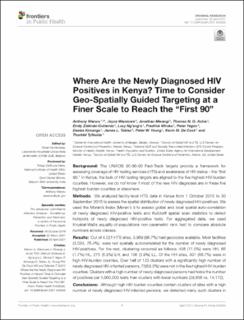| dc.contributor.author | Waruru, Anthony Kabui | |
| dc.contributor.author | Wamicwe, Joyce | |
| dc.contributor.author | Mwangi, Jonathan | |
| dc.contributor.author | Achia, Thomas N. O. | |
| dc.contributor.author | Zielinski-Gutierrez, Emily | |
| dc.contributor.author | Ng'ang'a, Lucy | |
| dc.contributor.author | Miruka, Fredrick | |
| dc.contributor.author | Yegon, Peter | |
| dc.contributor.author | Kimanga, Davies | |
| dc.contributor.author | Tobias, James L. | |
| dc.contributor.author | Young, Peter W. | |
| dc.contributor.author | De Cock, Kevin M. | |
| dc.contributor.author | Tylleskär, Thorkild | |
| dc.date.accessioned | 2022-02-01T09:40:22Z | |
| dc.date.available | 2022-02-01T09:40:22Z | |
| dc.date.created | 2022-01-24T10:58:48Z | |
| dc.date.issued | 2021 | |
| dc.identifier.issn | 2296-2565 | |
| dc.identifier.uri | https://hdl.handle.net/11250/2976190 | |
| dc.description.abstract | Background: The UNAIDS 90-90-90 Fast-Track targets provide a framework for assessing coverage of HIV testing services (HTS) and awareness of HIV status – the “first 90.” In Kenya, the bulk of HIV testing targets are aligned to the five highest HIV-burden counties. However, we do not know if most of the new HIV diagnoses are in these five highest-burden counties or elsewhere.
Methods: We analyzed facility-level HTS data in Kenya from 1 October 2015 to 30 September 2016 to assess the spatial distribution of newly diagnosed HIV-positives. We used the Moran's Index (Moran's I) to assess global and local spatial auto-correlation of newly diagnosed HIV-positive tests and Kulldorff spatial scan statistics to detect hotspots of newly diagnosed HIV-positive tests. For aggregated data, we used Kruskal-Wallis equality-of-populations non-parametric rank test to compare absolute numbers across classes.
Results: Out of 4,021 HTS sites, 3,969 (98.7%) had geocodes available. Most facilities (3,034, 76.4%), were not spatially autocorrelated for the number of newly diagnosed HIV-positives. For the rest, clustering occurred as follows; 438 (11.0%) were HH, 66 (1.7%) HL, 275 (6.9%) LH, and 156 (3.9%) LL. Of the HH sites, 301 (68.7%) were in high HIV-burden counties. Over half of 123 clusters with a significantly high number of newly diagnosed HIV-infected persons, 73(59.3%) were not in the five highest HIV-burden counties. Clusters with a high number of newly diagnosed persons had twice the number of positives per 1,000,000 tests than clusters with lower numbers (29,856 vs. 14,172).
Conclusions: Although high HIV-burden counties contain clusters of sites with a high number of newly diagnosed HIV-infected persons, we detected many such clusters in low-burden counties as well. To expand HTS where most needed and reach the “first 90” targets, geospatial analyses and mapping make it easier to identify and describe localized epidemic patterns in a spatially dispersed epidemic like Kenya's, and consequently, reorient and prioritize HTS strategies. | en_US |
| dc.language.iso | eng | en_US |
| dc.publisher | Frontiers Media | en_US |
| dc.rights | Navngivelse 4.0 Internasjonal | * |
| dc.rights.uri | http://creativecommons.org/licenses/by/4.0/deed.no | * |
| dc.title | Where Are the Newly Diagnosed HIV Positives in Kenya? Time to Consider Geo-Spatially Guided Targeting at a Finer Scale to Reach the “First 90” | en_US |
| dc.type | Journal article | en_US |
| dc.type | Peer reviewed | en_US |
| dc.description.version | publishedVersion | en_US |
| dc.rights.holder | Copyright © 2021 Waruru, Wamicwe, Mwangi, Achia, Zielinski-Gutierrez, Ng’ang’a, Miruka, Yegon, Kimanga, Tobias, Young, De Cock and Tylleskär. | en_US |
| dc.source.articlenumber | 503555 | en_US |
| cristin.ispublished | true | |
| cristin.fulltext | original | |
| cristin.qualitycode | 1 | |
| dc.identifier.doi | 10.3389/fpubh.2021.503555 | |
| dc.identifier.cristin | 1988365 | |
| dc.source.journal | Frontiers in Public Health | en_US |
| dc.identifier.citation | Frontiers in Public Health. 2021, 9, 503555. | en_US |
| dc.source.volume | 9 | en_US |

